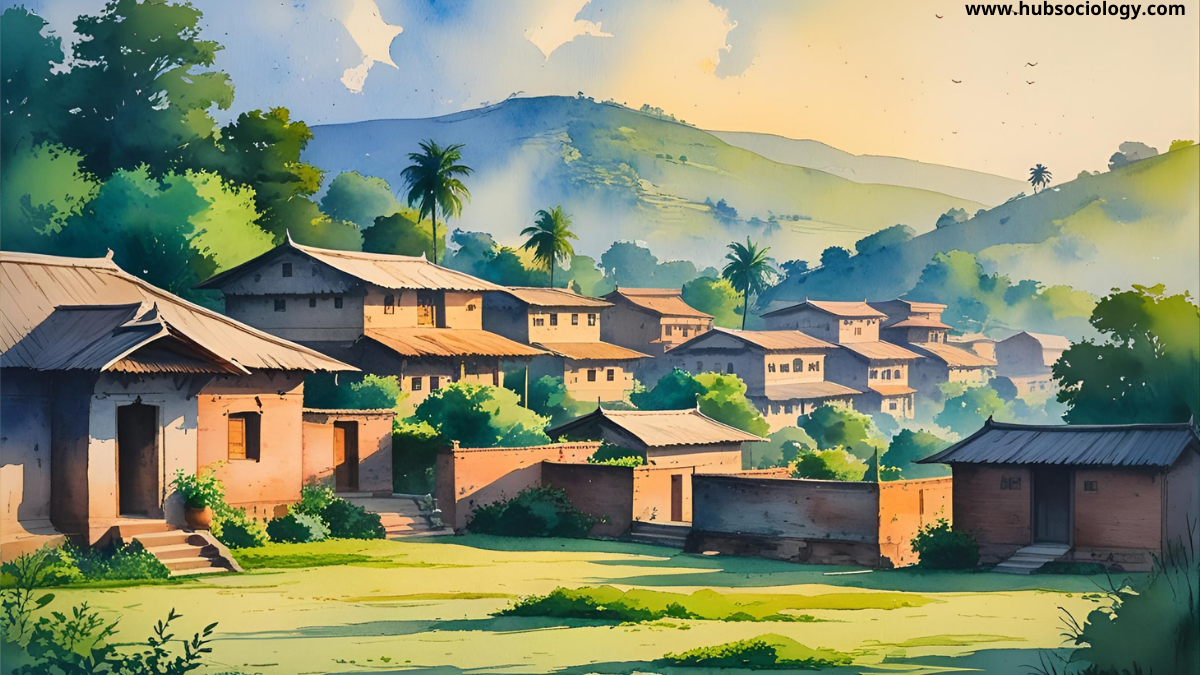Introduction on Types of Villages in India
India is a predominantly rural country, with approximately 65% of its population residing in villages. Villages in India are not uniform; they exhibit diverse social, economic, and cultural characteristics based on geographical location, historical background, and economic activities. Sociologically, villages can be classified based on various criteria such as social structure, economic activities, landholding patterns, and caste composition. Understanding these typologies helps in comprehending rural social organization, power dynamics, and developmental challenges.
This article explores the different types of villages in India from a sociological perspective, focusing on their structural and functional variations.

Table of Contents
1. Classification Based on Social Structure
(a) Caste-Based Villages
Indian villages have traditionally been organized around the caste system, which plays a crucial role in social stratification.
- Single-Dominant Caste Village: In such villages, one caste (often an upper or intermediate caste) holds significant economic and political power. Examples include Jat-dominated villages in Haryana or Reddy-dominated villages in Andhra Pradesh.
- Multi-Caste Village: These villages have multiple caste groups with no single dominant caste. Power is shared among different castes, though hierarchies persist. Most Indian villages fall into this category.
- Tribal Villages: Predominantly inhabited by Scheduled Tribes (STs), these villages have distinct cultural and social structures, often with minimal caste influence. Examples include villages in Jharkhand, Chhattisgarh, and Northeast India.
(b) Kinship-Based Villages
Some villages are structured around kinship ties, where most inhabitants belong to a single clan or lineage. This is common among tribal communities and certain agrarian castes where lineage and gotra (clan) play a significant role in social organization.
2. Classification Based on Economic Activities
(a) Agricultural Villages
The majority of Indian villages are agrarian, with farming as the primary occupation. These can be further divided into:
- Subsistence Farming Villages: Farmers grow crops primarily for self-consumption, with little surplus for the market. Common in remote and rain-fed areas.
- Commercial Farming Villages: Farmers engage in cash crops (e.g., cotton, sugarcane, tea) and are integrated into the market economy. Examples include villages in Punjab (wheat), Maharashtra (sugarcane), and Kerala (rubber).
(b) Artisanal and Craft-Based Villages
Some villages specialize in traditional crafts and artisanal work, such as:
- Pottery Villages (e.g., Khurja in Uttar Pradesh)
- Handloom Villages (e.g., Pochampally in Telangana)
- Metalwork Villages (e.g., Moradabad for brassware)
These villages often face challenges due to industrialization and declining demand for handmade products.

(c) Pastoral and Livestock-Based Villages
In arid and semi-arid regions, communities rely on animal husbandry. Examples include:
- Gujjar and Bakarwal communities in Jammu & Kashmir
- Rabari communities in Gujarat and Rajasthan
(d) Fishing Villages
Located near coastal areas, rivers, or lakes, these villages depend on fishing as their primary livelihood. Examples include:
- Villages in Kerala (e.g., Alappuzha)
- Sunderbans in West Bengal
3. Classification Based on Landholding Patterns
(a) Landlord-Dominated Villages (Zamindari System)
Historically, under the Zamindari system, a few landlords controlled vast lands, while peasants worked as tenants or laborers. Though Zamindari was abolished post-independence, remnants of landlord dominance persist in Bihar, Uttar Pradesh, and Telangana.
(b) Peasant-Proprietor Villages (Ryotwari System)
In these villages, land is owned by individual farmers rather than landlords. This system is prevalent in Maharashtra, Tamil Nadu, and parts of Karnataka.
(c) Collective Farming Villages (Bhoodan & Gramdan Movements)
Initiated by Vinoba Bhave, some villages adopted collective land ownership to reduce inequality. However, these models have seen limited success.
4. Classification Based on Settlement Patterns
(a) Nucleated Villages
Houses are clustered together, surrounded by farmland. Common in the Indo-Gangetic plains.
(b) Dispersed Villages
Houses are scattered over a large area, typical in hilly and forested regions (e.g., tribal villages in Odisha and Northeast India).
(c) Linear Villages
Houses are arranged along a road, river, or canal. Found in coastal areas and riverine belts.
5. Classification Based on Development and Modernization
(a) Traditional Villages
These villages retain age-old customs, agrarian economy, and minimal influence of urbanization. Social hierarchies are rigid, and modern amenities are scarce.
(b) Transitional Villages
Experiencing changes due to education, migration, and government schemes (e.g., MNREGA, SHGs). Caste rigidity is weakening, and non-farm employment is increasing.
(c) Developed/Modern Villages
These villages have better infrastructure, education, and healthcare. Some have diversified into agro-industries and tourism (e.g., villages in Punjab, Haryana, and Kerala).
6. Classification Based on Governance and Political Structure
(a) Panchayat-Run Villages
With the 73rd Constitutional Amendment, Panchayati Raj institutions play a key role in governance. Some villages have active local self-governance (e.g., Kerala’s decentralized planning model).
(b) Feudal or Dominant-Caste Controlled Villages
Despite democratic decentralization, some villages remain under the influence of powerful caste groups or political elites.
(c) Conflict-Affected Villages
Villages in regions like Jammu & Kashmir, Left-Wing Extremism (LWE) affected areas (Chhattisgarh, Jharkhand), or ethnic conflict zones (Manipur, Nagaland) have unique governance challenges.
Conclusion on Types of Villages in India
Indian villages are not homogeneous; they exhibit remarkable diversity in social organization, economic activities, and cultural practices. Sociologically, understanding these variations is crucial for policy formulation, rural development, and social empowerment. While some villages are rapidly modernizing, others remain entrenched in traditional structures. The interplay of caste, economy, and governance shapes the dynamics of rural India, making it a fascinating subject for sociological inquiry.

Efforts like digital India, rural electrification, and self-help groups are transforming villages, yet challenges of inequality, agrarian distress, and caste discrimination persist. A nuanced understanding of village typologies can aid in designing inclusive and sustainable development strategies for rural India.
Do you like this this Article ? You Can follow as on :-
Facebook – https://www.facebook.com/hubsociology
Whatsapp Channel – https://whatsapp.com/channel/0029Vb6D8vGKWEKpJpu5QP0O
Gmail – hubsociology@gmail.com
Topic Related Questions on Types of Villages in India
5 Marks Questions on Types of Villages in India (Short Answer Type)
- Define a single-dominant caste village with an example.
- Differentiate between nucleated and dispersed villages.
- What are pastoral villages? Give an example.
- How does the Zamindari system influence village structure in India?
- List three types of villages based on economic activities.
10 Marks Questions on Types of Villages in India (Detailed Answer Type)
- Explain the caste-based classification of Indian villages with examples.
- Discuss the impact of landholding patterns on village social structure.
- Compare and contrast agricultural villages and artisanal villages in India.
- How do kinship ties influence the social organization of tribal villages?
- Analyze the role of Panchayati Raj in transforming traditional villages.
15 Marks Questions on Types of Villages in India (Essay Type)
- “Indian villages exhibit diversity in social and economic structures.” Discuss this statement with reference to different types of villages.
- Examine the changing nature of Indian villages in the context of modernization and development.
- How do caste and land ownership shape power dynamics in rural India? Illustrate with examples.
- Critically evaluate the challenges faced by craft-based and fishing villages in contemporary India.
- Discuss the role of government policies in the transformation of rural settlements in India.

1 thought on “Types of Villages in India: A Sociological Perspective”